Surf Scoter Duck
- February 21, 2024
- 0 comment
The Surf Scoter duck, a striking sea bird native to North America, boasts an impressive appearance and fascinating behaviors that captivate birdwatchers and nature enthusiasts alike. Sporting glossy black plumage with contrasting white patches on the forehead and nape, male Surf Scoters are particularly eye-catching, while females exhibit a more subdued brownish-black coloring. What truly sets them apart is their vibrant orange bill, adorned with a distinctive black spot near the base, perfectly suited for capturing their preferred prey of mollusks, crustaceans, and other aquatic invertebrates.
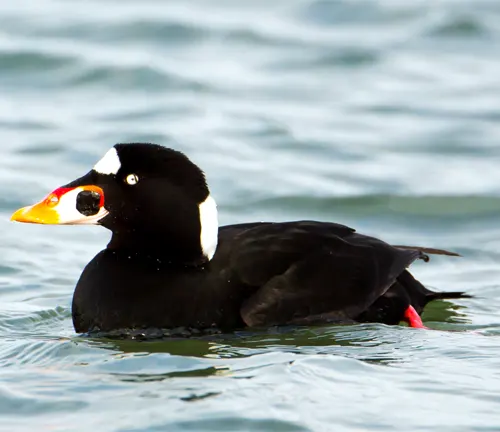
Renowned for their exceptional diving abilities, Surf Scoters can plunge to considerable depths in search of food, showcasing their agility and prowess in the water. Found along the coasts of North America, from Alaska to Baja California, these birds prefer habitats with ample access to open water, such as coastal bays and estuaries. While not currently considered globally threatened, Surf Scoters face conservation challenges due to habitat loss, pollution, and disturbance from human activities, highlighting the importance of ongoing conservation efforts to ensure their continued survival for generations to come.
| Aspect | Details |
|---|---|
| Scientific Name | Melanitta perspicillata |
| Common Name | Surf Scoter Duck |
| Adult Length | 18 – 21 inches (45 – 53 cm) |
| Adult Weight | 1.4 – 2.6 pounds (640 – 1,180 grams) |
| Wingspan | 26 – 30 inches (66 – 76 cm) |
| Plumage | Glossy black with white patches on forehead and nape (males), brownish-black (females) |
| Bill | Bright orange with black spot near base (males), similar bill with less intense coloring (females) |
| Habitat | Coastal waters, including bays, estuaries, and nearshore areas |
| Distribution | North America, from Alaska to Baja California |
| Feeding Behavior | Dive to capture mollusks, crustaceans, and other aquatic invertebrates |
| Dive Depth | Up to 30 meters (100 feet) or more |
| Breeding Season | Spring and early summer |
| Nesting Habitat | Coastal marshes, remote islands |
| Clutch Size | 5 – 9 eggs |
| Incubation Period | Approximately one month |
| Conservation Status | Not globally threatened, but faces conservation challenges due to habitat loss and human disturbances |
| Conservation Efforts | Habitat restoration, pollution control, research on migration patterns |
| Cultural Significance | Featured in traditional stories, art, and ceremonies |
A Fascinating Sea Bird
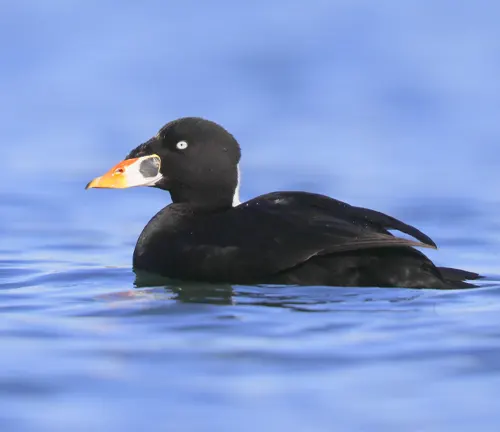
The Surf Scoter duck, also known simply as the Surf Scoter, is a captivating sea bird found along the coastal waters of North America. With its distinctive appearance and fascinating behaviors, the Surf Scoter holds a unique place in the avian world.
Physical Characteristics
Plumage
The plumage of the Surf Scoter is predominantly glossy black, which is more prominent in males. They have striking white patches on their forehead and nape, creating a stark contrast against their dark feathers. Female Surf Scoters have a more subdued brownish-black plumage with paler faces. This distinct plumage helps them blend into their coastal habitats while also serving as an attractive feature during courtship displays.
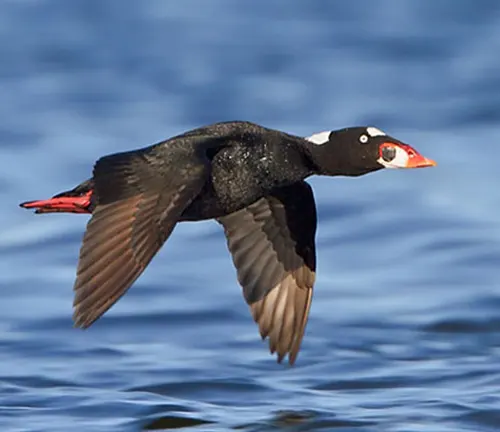

Bill
Perhaps the most distinctive feature of the Surf Scoter is its brightly colored bill. Male Surf Scoters sport a vibrant orange bill with a noticeable black spot near the base, adding to their overall striking appearance. Female Surf Scoters have a similar bill but with less intense coloring. The bill of the Surf Scoter is specially adapted for capturing and consuming their preferred prey of mollusks, crustaceans, and other aquatic invertebrates. Its unique shape and coloration make it a key characteristic for identifying this species in the wild.
Distribution and Habitat
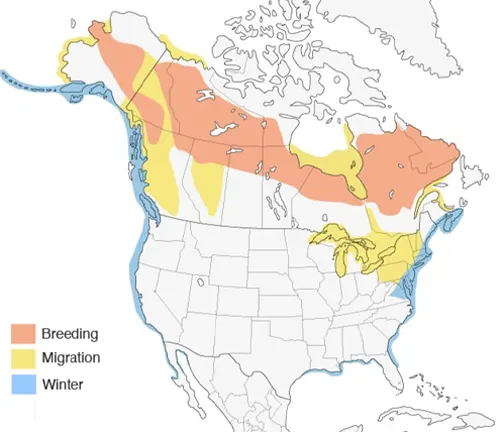
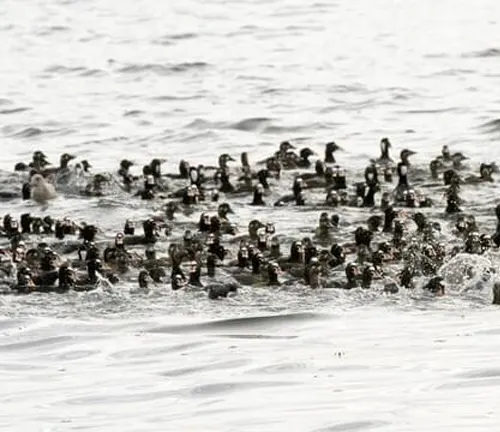
Surf Scoter ducks are primarily found along the coastal regions of North America, spanning from Alaska down to Baja California. They inhabit a variety of coastal habitats, including bays, estuaries, and nearshore waters. During the winter months, Surf Scoters can be observed in large flocks along both the Pacific and Atlantic coasts, where they take advantage of the abundance of food resources found in these areas. Their preference for coastal habitats with access to open water makes them well-suited for foraging on mollusks, crustaceans, and other aquatic invertebrates. These adaptable birds are also known to inhabit inland bodies of water such as large lakes or reservoirs, particularly during migration periods or in areas with suitable feeding grounds. Overall, Surf Scoters are highly adaptable and can thrive in a range of coastal environments throughout their distribution range.
Feeding Behavior
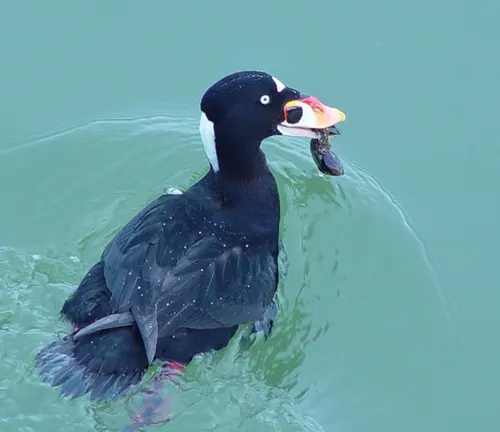
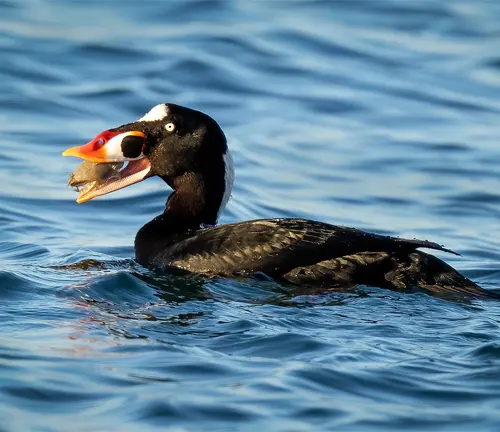
Surf Scoter ducks are primarily diving birds, well adapted to foraging for food beneath the water’s surface. They have a diverse diet consisting mainly of mollusks, crustaceans, and other aquatic invertebrates. Using their specialized bills, Surf Scoters dive underwater to capture their prey, which may include species such as clams, mussels, crabs, and shrimp. These ducks are capable of diving to considerable depths, often reaching depths of up to 30 meters (100 feet) or more in search of food. Their streamlined bodies and powerful wings enable them to navigate through the water with agility and efficiency. Surf Scoters are opportunistic feeders and may also consume small fish, fish eggs, and aquatic plants when available. Their feeding behavior is closely tied to the availability of food resources in their coastal habitats, and they may adjust their foraging strategies in response to changes in prey abundance or environmental conditions. Overall, the diving abilities and versatile diet of Surf Scoter ducks contribute to their success as marine predators in coastal ecosystems.
Diving Abilities
Surf Scoter ducks are renowned for their exceptional diving abilities, which allow them to explore the depths of coastal waters in search of food. These birds are capable of diving to impressive depths, often reaching depths of up to 30 meters (100 feet) or more. Their streamlined bodies and powerful wings enable them to propel themselves underwater with remarkable speed and agility.

Surf Scoters use their specialized bills to capture prey while diving, grasping onto mollusks, crustaceans, and other aquatic invertebrates found on the seafloor or among submerged vegetation. Their keen eyesight and acute sense of direction help them navigate through the underwater environment, allowing them to locate and capture prey with precision.
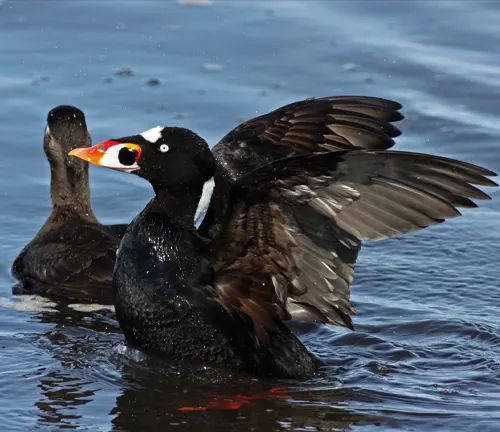
Migration Patterns
Surf Scoter ducks are migratory birds that undertake long-distance journeys between their breeding and wintering grounds. During the breeding season, which typically occurs in spring and early summer, Surf Scoters can be found in northern regions of North America, including Alaska and Canada. Here, they establish nesting sites in coastal marshes or on remote islands, where females lay their eggs and incubate them for around a month before hatching.
Breeding and Reproduction
Breeding and Reproduction
Surf Scoter ducks engage in elaborate courtship rituals during the breeding season, which typically occurs in spring and early summer. Males use a variety of displays and vocalizations to attract females, including head bobbing, wing flapping, and calling. Once a pair bond is formed, the male and female Surf Scoters will establish a nesting site in a suitable coastal habitat, such as a marsh or remote island.
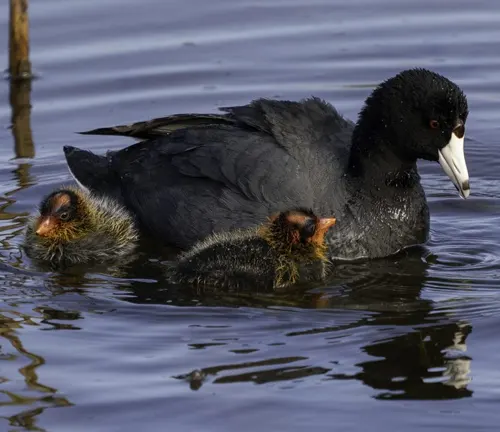
Female Surf Scoters typically lay a clutch of 5 to 9 eggs, which are usually laid in a shallow depression lined with grasses or other vegetation to provide insulation and protection. The eggs are incubated primarily by the female for around a month until they hatch. Both parents take turns incubating the eggs and caring for the young once they hatch.
Conservation Status
The Surf Scoter duck is currently classified as a species of “Least Concern” by the International Union for Conservation of Nature (IUCN). This designation suggests that overall population levels are stable, and the species is not currently facing imminent threats of extinction. However, despite this relatively positive status, Surf Scoters still face a range of conservation challenges that require attention and action to ensure their long-term survival and well-being.
Threats and Challenges
Surf Scoters encounter various threats and challenges that impact their populations and habitats. One significant threat is habitat loss and degradation, primarily driven by coastal development, pollution, and disturbances from human activities. Coastal habitats, including marshes, estuaries, and nearshore areas, are crucial for Surf Scoters for feeding, nesting, and resting. Loss of these habitats can disrupt their life cycle and reduce their access to essential resources.
Pollution, particularly from oil spills and contaminants, poses another significant threat to Surf Scoters. Oil spills can coat their feathers, impairing their ability to regulate body temperature and repel water, leading to hypothermia and death. Ingestion of pollutants can also have detrimental effects on their health and reproductive success.
Conservation Efforts
Numerous conservation efforts are underway to protect Surf Scoters and their habitats. Habitat restoration and conservation initiatives aim to restore degraded coastal habitats and create protected areas where Surf Scoters can feed, nest, and rest undisturbed. Pollution control measures, such as regulations on oil drilling and shipping practices, help minimize the risk of oil spills and contamination.
Research on Surf Scoter biology, ecology, and behavior provides valuable insights into their conservation needs and informs management decisions. Monitoring programs track population trends, migration patterns, and breeding success to assess the effectiveness of conservation efforts and identify areas for improvement.
Fun Facts about Surf Scoters
- Surf Scoters are among the largest of the scoter species, with males weighing up to 2 kilograms (4.4 pounds).
- Despite their somewhat ungainly appearance on land, Surf Scoters are graceful and agile swimmers, capable of diving and maneuvering with ease.
- During the breeding season, male Surf Scoters emit distinctive calls and engage in elaborate displays, including head bobbing and wing flapping, to attract females.
Different Species
White-winged Scoter
(Melanitta deglandi)
This species is similar in appearance to the Surf Scoter but has distinctive white patches on its wings, which are visible during flight.
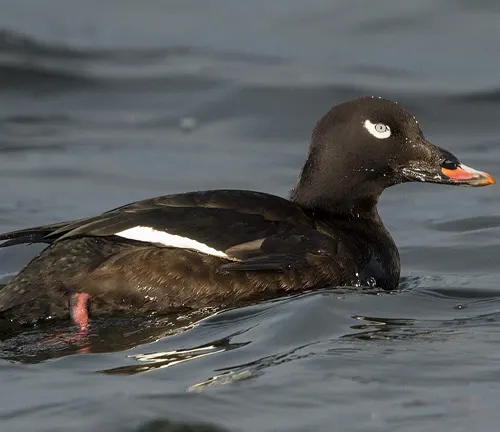
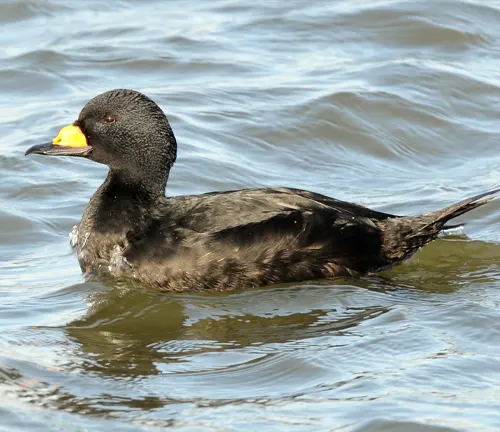
Black Scoter
(Melanitta americana)
Another closely related species, the Black Scoter, is characterized by its entirely black plumage, lacking the white patches seen in Surf Scoters.
Velvet Scoter
(Melanitta fusca)
Found in Europe and Asia, the Velvet Scoter is larger than the Surf Scoter and has a velvety black plumage, with males exhibiting a white patch on the forehead.

Frequently Asked Frequently (FAQs)
- Are Surf Scoters endangered?
Surf Scoters are not currently considered globally threatened, but they face conservation challenges due to habitat loss, pollution, and human disturbances. - Where do Surf Scoters live?
Surf Scoters are primarily found along the coasts of North America, from Alaska to Baja California, where they inhabit coastal waters including bays, estuaries, and nearshore areas. - What do Surf Scoters eat?Surf Scoters primarily feed on mollusks, crustaceans, and other aquatic invertebrates, which they capture by diving beneath the water’s surface.
- How deep can Surf Scoters dive?
Surf Scoters are capable of diving to depths of up to 30 meters (100 feet) or more in search of food, showcasing their exceptional diving abilities. - Do Surf Scoters migrate?
Yes, Surf Scoters undertake long-distance migrations between their breeding and wintering grounds. They breed in northern regions of North America before migrating south to warmer coastal waters for the winter. - How can I identify a Surf Scoter?
Surf Scoters can be identified by their glossy black plumage (with white patches on males), bright orange bill with a black spot near the base, and their behavior of diving for food. - What are the predators of Surf Scoters?
Predators of Surf Scoters include large birds of prey such as eagles and hawks, as well as some mammalian predators like foxes and raccoons. - How do Surf Scoters communicate?
Surf Scoters communicate through vocalizations, including various calls and sounds used for mating, territory defense, and social interactions. - Do Surf Scoters breed in colonies?
While Surf Scoters may congregate in small groups during the breeding season, they typically do not form large colonies like some other seabird species. - How long do Surf Scoters live?
The average lifespan of Surf Scoters in the wild is around 10-15 years, although some individuals may live longer under optimal conditions. - What conservation efforts are in place to protect Surf Scoters?
Conservation efforts for Surf Scoters include habitat restoration, pollution control, research on migration patterns, and public awareness campaigns to promote their conservation. - Do Surf Scoters have any predators in the water?
While Surf Scoters are skilled divers and may evade some aquatic predators, they may still be preyed upon by large fish such as sharks or seals in certain circumstances.


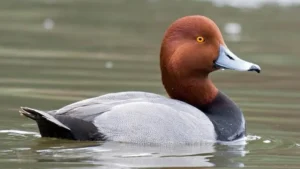
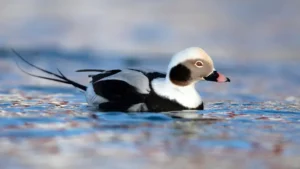
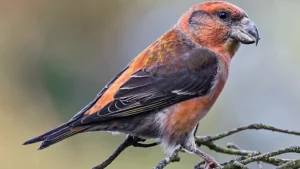
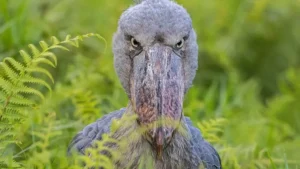
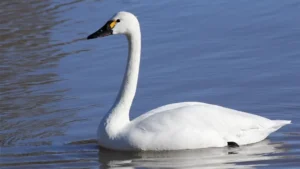
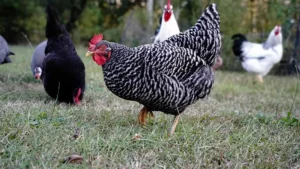
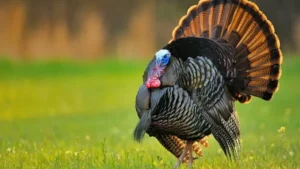
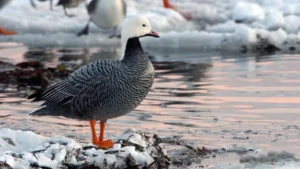

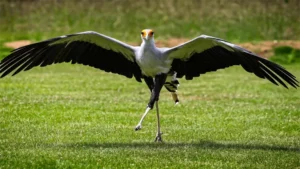
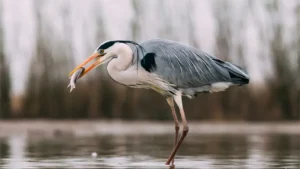

Leave your comment